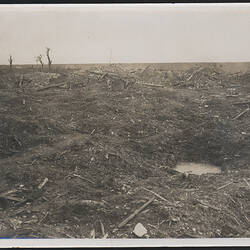Summary
Certificate documenting the burial of World War I solider James Clive Talbot at Ypres Reservoir British Cemetery, Belgium. His father James (or perhaps both his parents) appears to have taken the unusual step of visiting his grave - out of the reach of the majority of bereaved in Australia.
James Clive Talbot was a 20-year-old grazier and wool classer from 'Yeo Vale', Birregurra, Victoria, when he enlisted to fight in World War I on 2 April 1915 (service #1350). As part of the 24th Battalion he served in Gallipoli and on the Western Front. He was killed in action aged 22, on 22 September 1917 in Belgium (during in the Third Battle of Ypres). His parents placed a Blackwood pulpit at the Birregurra Church of England, in memory of their son, who they knew as Clive. It is inscribed '...in loving memory of our beloved son and brother, James Clive Talbot, killed in action September 22nd, 1917, aged 22 years. He has fought a good fight, he has finished his work; he has kept the faith.'
Talbot's service record indicates that his father James planned to visit the grave in early March 1919, and requested a photograph and map of the cemetery to assist his visit. James and his wife departed for Europe on the Makura in early May 1919 - 'Their only son, Lieut. Clive Talbot, was killed in France, and they hope to visit his grave' (Table Talk, 8 May 1919). They returned in January the following year on the Orsova (Table Talk, 15 Jan 1920). In August 1926 James Talbot requested a photograph of Clive's grave with its 'permanent' headstone.
Early in World War I the Federal government decided that it would be impractical to return the remains of Australian soldiers to Australia. War graves were gradually established, ultimately to be placed under the control of the Commonwealth War Graves Commission. After the War, many families sought to visit the graves or memorials of their loved ones. They were largely dissuaded until most burials were complete, as human remains were still scattered across the battlefields. By 1921 visitors were officially allowed to visit Gallipoli. Persistent inquiries about travel led the Minister of Defence, G.F. Pearce, to recommend the establishment of an advisory bureau to assist travellers to a range of European and other sites. In 1924 alone the Australian Graves Service assisted 1100 people, visiting the remains of some of the 60,000 servicepeople who never returned home.
The Commonwealth War Graves Commission indicates that the Ypres Reservoir Cemetery was founded in October 1915 and was used by fighting units and field ambulances until after the Armistice, when it contained 1,099 graves. After World War I the cemetery was enlarged as remains were gathered from the battlefields and smaller burial grounds were closed. Today, 2,613 Commonwealth servicemen are buried in this cemetery.
Physical Description
Printed certificate with gold and black text, surrounded by black and white photographic images of memorials: South Africa, Ulster, Australian and Highland. The principal lower image shows the Ypres Reservoir British Cemetry, Belgium. The focal point of the certificate is a printed label, adhered, providing the personal details of a single soldier's burial: James Clive Talbot. The label appears within a gold holly garland.
Significance
The James Talbot mourning collection is of particular significance since it documents a set of personal effects from a son lost at war, including a tiny photograph and engraved medal presented to his bereaved parents, and his colour patch, buttons and badges. Importantly, it also includes a large certificate from Ypres Reservoir British Cemetery, Belgium, including cemetery images and Talbot's details pasted into a box at the centre. (Further research may link this to his father's visit to the cemetery.) It provides an important insight into the ways Australians memorialized the distant graves of their loved ones (discussed by Bart Ziino in A Distant Grief, and others).
More Information
-
Collecting Areas
-
Acquisition Information
Purchase
-
Person Commemorated
Private James C. Talbot - Australian Imperial Force (AIF), Ypres Reservoir British Cemetery, Ypres, Belgium, circa 1919
-
Organisation Symbolised
-
Inscriptions
Printed: ' 1914 / 1918 / FOR KINGAND COUNTRY FOR THE GLORY OF GOD AND IN EVERLASTING MEMORY OF / [printed label, adhered:] TALBOT / Gnr. James Clive. 1350. 2nd Div, / Trench Mortar Bty. Australian Field Artillery. / Killed in action 22nd Sept., 1917. Age 22. Son of / James R. and Lottie Dora Talbot, of Yeo Vale, / Birregurra, Victoria, Australia. I. E. 9 [end of adhered label] / WHO GAVE HIS LIFE IN THE GREAT WAR / THAT WE MIGHT LIVE / AND WHOSE NAME IS CARVED IN STONE / AT / YPRES RESERVOIR BRISTISH CEMETARY - BELGIUM' . Further texts in columns down the sides of the certificate list place names where significant battles were fought.
-
Classification
-
Category
-
Discipline
-
Type of item
-
Overall Dimensions
321 mm (Width), 501 mm (Height)
-
References
Bart Ziino, 2007. A Distant Grief: Australians, War Graves and the Great War. University of Western Australia Press. Commonwealth War Graves Commission web site [Link 1] accessed 3/1/2014. JULY. (1919, May 8). Table Talk (Melbourne, Vic. : 1885 - 1939), p. 29. Retrieved April 20, 2015, from [Link 2] Social. (1920, January 15). Table Talk (Melbourne, Vic. : 1885 - 1939), p. 30. Retrieved April 20, 2015, from [Link 3]
-
Keywords
World War I, 1914-1918, Certificates, Service, Memorials, Death & Mourning, Battle of the Somme (Somme Offensive), 1916

